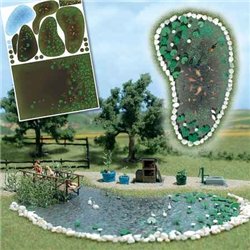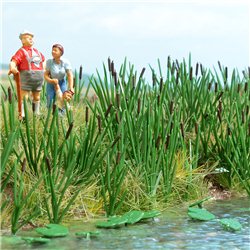There are a number of different options for attaching figures such as a horse and rider to a layout. Perhaps the...
No products
Product successfully added to your shopping cart
There are 0 items in your cart. There is 1 item in your cart.
Search Tips
What colour should I paint my model pond?
When painting a model pond, the colour choices are crucial for achieving a realistic effect, as water in nature reflects the environment and interacts with light. The base colours you choose should mimic the depth, clarity, and surroundings of the pond you are trying to replicate. The aim is to create the illusion of water depth, movement, and reflection, which can be tricky but rewarding when done right.
Start by considering the depth of the pond. For deeper ponds, a darker base is essential to suggest depth. Colours such as dark green, deep blue, or even black can be used to create the sense that the pond is deep and murky. A good technique is to blend these darker shades at the centre of the pond and lighten them toward the edges, where the water would naturally be shallower. For a shallow pond or stream, lighter greens, browns, and sandy yellows work well to suggest transparency and shallow water.
Next, think about the clarity of the water. If you want to represent clear water, the base colour should reflect the natural earth tones underneath the surface, like browns, ochres, and soft greens, with a slightly blue tint on top to simulate clean, fresh water. On the other hand, if the pond is more stagnant or murky, incorporating browns, muddy greens, and even dark greys can give the impression of dirt, algae, or decay. Be sure to add subtle gradients and blending between these colours to avoid a flat, unrealistic look.
The surroundings of the pond also play a key role in determining the colours. If the pond is situated in a forest or heavily vegetated area, more greens and browns should dominate the palette to reflect the foliage and the earthy surroundings. In contrast, if your pond is part of an urban or park scene, it might benefit from a cooler palette with more greys and blues to reflect sky and structures nearby.
Consider adding subtle highlights to simulate the reflective surface of the water. This can be done by dry-brushing light blues, greys, or even white along the areas that would naturally catch light, such as the edges or the tops of waves if you're including any water movement. This step helps to add realism by creating the illusion of a reflective surface and depth within the pond.
Lastly, don’t forget the finishing touches. Applying a glossy varnish after painting is essential for giving the pond that shiny, water-like finish. If you're feeling more advanced, using layers of clear resin can enhance the depth effect and allow you to add details like rocks, plants, or even fish beneath the surface.
Click here to receive the tips weekly in your mailbox. You can unsubscribe at any time.










